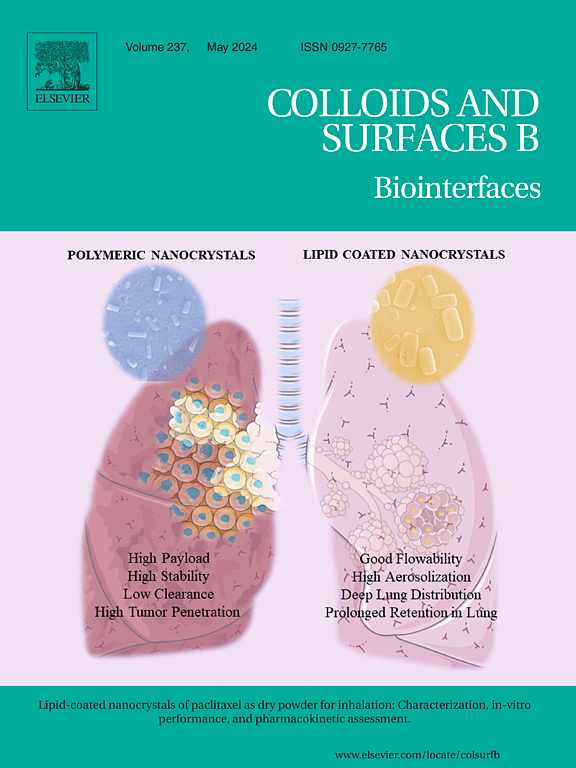Entrapping imipenem into poly(methyl methacrylate) assemblies by microfluidic process retains the activity against prosthetic joint infections following thermal treatment
IF 5.4
2区 医学
Q1 BIOPHYSICS
引用次数: 0
Abstract
To prevent prosthetic joint infections (PJIs) in patients, bone cement powder is often pre-filled with antibiotics. However, most broad-spectrum antibiotics are heat-unstable, complicating their incorporation into bone cement. In this study, we entrapped a heat-labile antibiotic imipenem (IMP) into the bone cement basal material poly(methyl methacrylate) (PMMA) to combat broad-spectrum PJI. First, the IMP-PMMA matrix was fabricated via self-assembly using microfluidic devices. Then, the IMP-PMMA assemblies were characterized by examining their structural features, thermal behavior, and the in vitro release profile of IMP from the PMMA matrix. Finally, we investigated the relationship between the thermal treatment and antibacterial activity of IMP-loaded PMMA. Our results demonstrated that preloading IMP into PMMA could potentially protect IMP from heat damage during acrylic bone cement preparation, thereby retaining its antibacterial activity against bacterial infections. The insights gained from this study suggest that IMP-loaded acrylic bone cement is a promising strategy for preventing PJIs in orthopedic surgery.
通过微流控工艺将亚胺培南包埋到聚甲基丙烯酸甲酯(甲基丙烯酸甲酯)组装体中,保留了热处理后抗假体关节感染的活性
为了防止患者假体关节感染(PJIs),骨水泥粉末通常预先填充抗生素。然而,大多数广谱抗生素都是热不稳定的,这使得它们与骨水泥的结合变得复杂。在这项研究中,我们将一种热不稳定的抗生素亚胺培南(IMP)包埋在骨水泥基材料聚甲基丙烯酸甲酯(PMMA)中,以对抗广谱PJI。首先,利用微流控装置自组装制备IMP-PMMA基质。然后,通过检测IMP-PMMA复合物的结构特征、热行为以及IMP从PMMA基质的体外释放谱来表征IMP-PMMA复合物。最后,我们研究了imp负载PMMA的热处理与抗菌活性的关系。我们的研究结果表明,将IMP预加载到PMMA中可以潜在地保护IMP在丙烯酸骨水泥制备过程中免受热损伤,从而保持其对细菌感染的抗菌活性。从这项研究中获得的见解表明,imp负载的丙烯酸骨水泥是预防骨科手术中PJIs的一种有前途的策略。
本文章由计算机程序翻译,如有差异,请以英文原文为准。
求助全文
约1分钟内获得全文
求助全文
来源期刊

Colloids and Surfaces B: Biointerfaces
生物-材料科学:生物材料
CiteScore
11.10
自引率
3.40%
发文量
730
审稿时长
42 days
期刊介绍:
Colloids and Surfaces B: Biointerfaces is an international journal devoted to fundamental and applied research on colloid and interfacial phenomena in relation to systems of biological origin, having particular relevance to the medical, pharmaceutical, biotechnological, food and cosmetic fields.
Submissions that: (1) deal solely with biological phenomena and do not describe the physico-chemical or colloid-chemical background and/or mechanism of the phenomena, and (2) deal solely with colloid/interfacial phenomena and do not have appropriate biological content or relevance, are outside the scope of the journal and will not be considered for publication.
The journal publishes regular research papers, reviews, short communications and invited perspective articles, called BioInterface Perspectives. The BioInterface Perspective provide researchers the opportunity to review their own work, as well as provide insight into the work of others that inspired and influenced the author. Regular articles should have a maximum total length of 6,000 words. In addition, a (combined) maximum of 8 normal-sized figures and/or tables is allowed (so for instance 3 tables and 5 figures). For multiple-panel figures each set of two panels equates to one figure. Short communications should not exceed half of the above. It is required to give on the article cover page a short statistical summary of the article listing the total number of words and tables/figures.
 求助内容:
求助内容: 应助结果提醒方式:
应助结果提醒方式:


